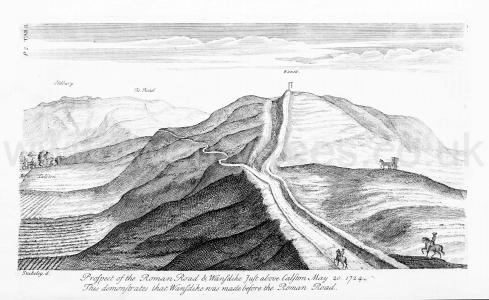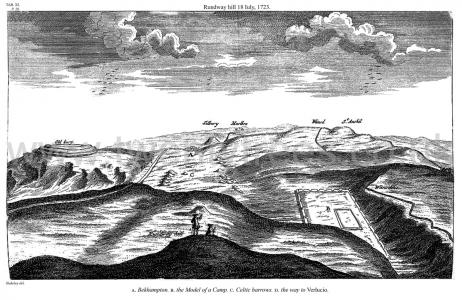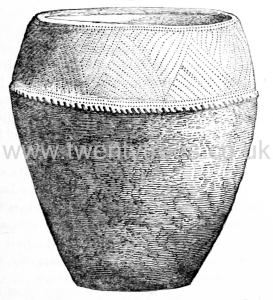Europe, British Isles, South-West England, Wiltshire, Calne
Calne, Wiltshire is in Wiltshire.
William of Malmesbury Book 2 Chapter 9. 975In the year of our Lord 975, Edward (age 13) the son of Edgar (age 32) began to reign, and enjoyed the sovereignty for three years and a half. Dunstan (age 66), in common consent with the other bishops, elevated him to the royal dignity, in opposition, as it is said, to the will of some of the nobility, and of his stepmother (age 30); who was anxious to advance her son Ethelred (age 9), a child scarcely seven years of age, in order that herself might govern under colour of his name. Then, from the increasing malice of men, the happiness of the kingdom was impaired; then too, comets were seen, which were asserted certainly to portend either pestilence to the inhabitants, or a change in the government. Nor was it long ere there followed a scarcity of corn; famine among men; murrain among cattle; and an extraordinary accident at a royal town called Calne. For as soon as Edgar (age 32) was dead, the secular canons who had been for some time expelled their monasteries, rekindled the former feuds, alleging, that it was a great and serious disgrace, for new comers to drive the ancient inmates from their dwellings; that it could not be esteemed grateful to God, who had granted them their ancient habitations: neither could it be so to any considerate man, who might dread that injustice as likely to befall himself, which he had seen overtake others. Hence they proceeded to clamour and rage, and hastened to Dunstan (age 66); the principal people, as is the custom of the laity, exclaiming more especially, that the injury which the canons had wrongfully suffered, ought to be redressed by gentler measures. Moreover, one of them, Elferius, with more than common audacity, had even overturned almost all the monasteries which that highly revered monk Ethelwold, bishop of Winchester (age 71), had built throughout Mercia. On this account a full synod being convened, they first assembled at Winchester. What was the issue of the contest of that place, other writings declare;1 relating, that the image of our Saviour, speaking decidedly, confounded the canons and their party. But men's minds being not yet at rest on the subject, a council was called at Calne; where, when all the senators of England, the king being absent on account of his youth, had assembled in an upper chamber, and the business was agitated with much animosity and debate; while the weapons of harsh reproach were directed against that firmest bulwark of the church, I mean Dunstan (age 66), but could not shake it; and men of every rank were earnestly defending their several sides of the question; the floor with its beams and supporters gave way suddenly and fell to the ground. All fell with it except Dunstan (age 66), who alone escaped unhurt by standing on a single rafter which retained its position: the rest were either killed, or subjected to lasting infirmity. This miracle procured the archbishop peace on the score of the canons; all the English, both at that time and afterwards, yielding to his sentiments.
Note 1. When the question was agitated, whether the monks should be supported or the canons restored, the crucifix is said to have exclaimed, "Far be it from you: you have done well; to change again would be wrong". See Edmer, and Osberne, Angl. Sacra, ii. 219, 112.
Anglo-Saxon Chronicle. 978. This year all the oldest counsellors of England fell at Calne from an upper floor; but the holy Archbishop Dunstan (age 69) stood alone upon a beam. Some were dreadfully bruised: and some did not escape with life.
Europe, British Isles, South-West England, Wiltshire, Calne Without 1 Long Barrow [Map]
Calne Without 1 Long Barrow is also in South England Neolithic Long Barrows.
Wiltshire Archaeological Magazine 1913 V38 Pages 379-414. Calne Without. 1. [Calne Without 1 Long Barrow [Map]] About ¼ of a mile W. of Cherhill Monument. Length? E. and W. The remains of a long-shaped mound, much cut about at both ends by stone diggers; perhaps the remnant of a Long Barrow; nothing seems to be known of its history. O.M. 27 SE. For the barrow also near Cherhill Monument, referred to by Thurnam as " Oldbury," see under Cherhill.
Europe, British Isles, South-West England, Wiltshire, Calne, Calstone Wellington [Map]
Europe, British Isles, South-West England, Wiltshire, Calne, Calstone Wellington, View of Calston [Map]
Stonehenge by William Stukeley. Table II. Prospect of the Roman Road & Wansdyke just above Caston May 20 1724. This demonstrates that Wansdyke was made before the Roman Road. [Note. Stukeley would have been stood here [Map] to record this view. Note the gibbet on top of Furze Knoll [Map]. On the left Cherhill aka Oldbury Hill Fort [Map].]

Europe, British Isles, South-West England, Wiltshire, Calne, Cherhill aka Oldbury Hill Fort [Map]
Cherhill aka Oldbury Hill Fort is also in Iron Age Hill Forts Wiltshire.
Stonehenge by William Stukeley. Table II. Prospect of the Roman Road & Wansdyke just above Caston May 20 1724. This demonstrates that Wansdyke was made before the Roman Road. [Note. Stukeley would have been stood here [Map] to record this view. Note the gibbet on top of Furze Knoll [Map]. On the left Cherhill aka Oldbury Hill Fort [Map].]

Avebury by William Stukeley. 18 Jul 1728. Table XI. Rundway hill 18 July, 1723. A. Bekhampton. B. the Model of a Camp. C. Celtic barrows. D. the way to Verlucio. [The drawing shows Silbury Hill [Map] and Cherhill aka Oldbury Hill Fort [Map]]

Europe, British Isles, South-West England, Wiltshire, Calne, Furze Knoll [Map]
Stonehenge by William Stukeley. Table II. Prospect of the Roman Road & Wansdyke just above Caston May 20 1724. This demonstrates that Wansdyke was made before the Roman Road. [Note. Stukeley would have been stood here [Map] to record this view. Note the gibbet on top of Furze Knoll [Map]. On the left Cherhill aka Oldbury Hill Fort [Map].]

The Wiltshire Wansdye remains highly visible in the landscape especially when it is crossing chalk downland that has little vegetation to hide it. Its date is somewhat uncertain; most sources consider it to have been constructed around 600AD give or take a hundred years either was. It was definitely constructed before the 9th century when begins to occur in charters.
It appears to start west of Savernake Forest [Map], after which it travels broadly west through Shaw Medieval Village [Map], Furze Hill [Map], Tan Hill, Wiltshire [Map], Shepherd's Shore, Wiltshire [Map], Furze Knoll [Map] after which it disappears, possibly being absorbed into the Roman Road
Europe, British Isles, South-West England, Wiltshire, Calne, Oldbury Long Barrow [Map]
Oldbury Long Barrow is also in South England Neolithic Long Barrows.
Wiltshire Archaeological Magazine 1872 V13 Page 103. Notes of a Long Barrow [Map] on Oldbury Hill
Wiltshire Archaeological Magazine 1913 V38 Pages 379-414. Cherhill. 1a. [Oldbury Long Barrow [Map]] Just outside the ramparts of Oldbury Camp, W. of the monument, on the Cherhill — Calne Without parish boundary. Length 60ft. ( Wm. Cunnington1 ); E. and W. This barrow has been practically destroyed by flint diggers, only a confused heap now remaining. During this digging in 1864 some human bones were found, and Wm. Cunnington visited the spot and further examined the mound. Three skeletons were found " lying with their heads towards the E. in a large shallow grave surrounded by small blocks of sarsen stone."2 A second grave was found empty, and in the mound a worn mealing stone of sarsen (Devizes Museum Cat. II. X. 96a) and charcoal. O.M. 27 SE.; Arch. xlii. 203, 218; Mem. Anthrop. Soc. I. 473; W.A.M. xiii. 103 (Cunnington); Smith p. 50, III. C. v. d.: MS. Cat. No. 198.
The barrow is not shown on the O.M. The site may be found by prolonging the curve of the ditch of the outer rampart of the camp to the point where it cuts the parish boundary, just N. of the track. This barrow is referred to by Thurnam as "Oldbury."
Note 1. To avoid confusion it is perhaps as well to explain that there are two William Cunningtons referred to in this list. The elder and contemporary of Sir R. Colt Hoare died in 1810, the younger, who was his grandson, died in 1906.
Note 2. Thurnam has included this among his list of chambered barrows, but this account by Wm. Cunnington, who himself examined the mound, hardly seems to justify its description as a "chambered" barrow.
Memoirs of the Anthropological Society of London Volume 1. Skulls from Long Barrow, Oldbury [Map], Wilts.—In the same year (1864), in digging in a chalk-pit near the ancient British camp of Oldbury, North Wiltshire, about three miles from the elebrated megalithic circles at Avebury, two or three skeletons were uncovered at the base of the east end of what turned out to be a long barrow, of low elevation. The measurements of three skulls, which, though quite dolichocephalous, are of small size, and not very characteristic, are given in the table. Two of the skulls appear to be those of women, and are in the possession of Mr. Cunnington, of Devizes, who assisted in their exhumation. The other skull, that of a man, has been added to my collection (No. 198). Near the skeletons were a number of flint flakes, with one or two cores, from which they had been broken off. At the centre of the mound was a small irregularly-shaped cist, built up with sarsen stones: it was empty. This tumulus, though of oblong form, has not the unequivocal characters of a long barrow ; it appears, however, to have belonged to that class.
Europe, British Isles, South-West England, Wiltshire, Calne, Oldbury Round Barrow [Map]
Oldbury Round Barrow is also in South England Bronze Age.
Wiltshire Archaeological Magazine 1859 V6 Pages 73-74. Account of a Barrow on Oldbury Hill [Map], Wilts. Opened by Mr Cunnington, F.G.S, February 1853.
Funereal Urn, found in a barrow on Oldbury Hill, Wilts. In the Museum of the Wilts Archaeological and Natural History Society, from a photograph by Marshman.
